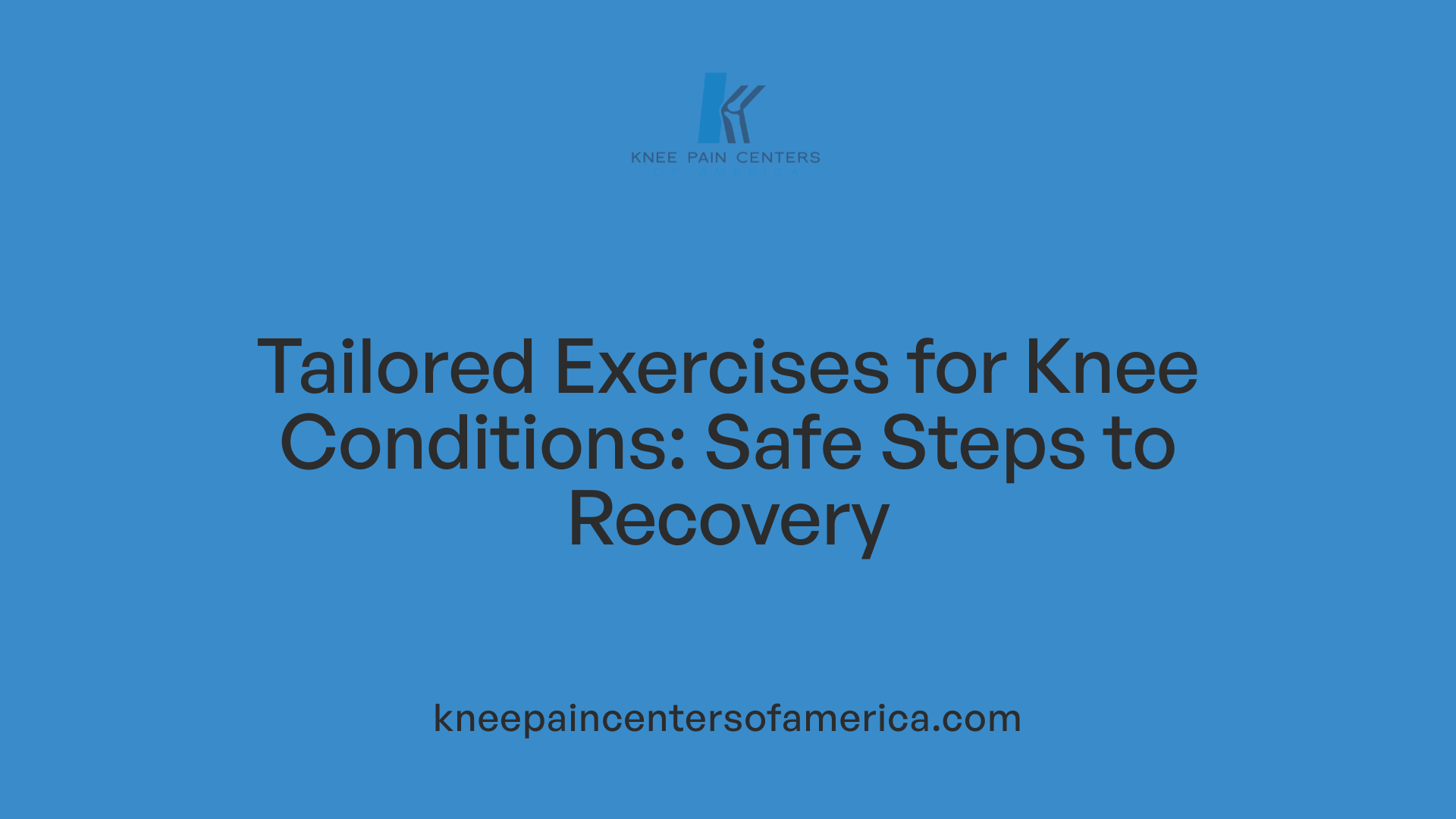Importance of Knee Strength and Stability
Healthy knees are vital for mobility, preventing injuries, and managing conditions like arthritis. Strengthening the muscles that support the knee can significantly improve joint stability, reduce pain, and enhance overall joint health. This comprehensive guide explores effective exercises and stretches, proper techniques, routines for different needs, and practical tips to keep your knees strong and healthy.
Understanding Knee Anatomy and the Role of Supporting Muscles

What are the components of the knee joint?
The knee joint is a complex assembly of bones, ligaments, tendons, menisci, and cartilage that work together to enable movement and bear weight. The primary bones involved are the femur (thigh bone), tibia (shin bone), and patella (kneecap). Ligaments such as the anterior cruciate ligament (ACL) and posterior cruciate ligament (PCL) provide stability, while tendons connect muscles to bones. The menisci are cartilage discs that cushion the joint, and articular cartilage covers the ends of bones to facilitate smooth movement.
Which muscles support the knee?
Several major muscle groups play essential roles in supporting the knee. The quadriceps, located at the front of the thigh, extend the knee and help absorb shock. The hamstrings, at the back of the thigh, bend the knee and provide stability during movement. The gluteal muscles (glutes) help stabilize the pelvis and control leg movements, which indirectly support the knees. Hip flexors also contribute to leg mobility and stability, ensuring proper alignment during activities.
How do these muscles assist in shock absorption, stabilization, and movement?
Muscles around the knee act as natural shock absorbers. For example, strong quadriceps and hamstrings absorb forces exerted during walking, running, or jumping, reducing stress on the joint. They also stabilize the knee by maintaining proper alignment through coordinated activity, preventing abnormal movements that could cause injury. Moreover, flexible and strong muscles enable a full range of motion, allowing smooth and controlled movement, which is vital for daily activities and athletic pursuits.
Why is muscle strength important for knee health?
Maintaining strong, flexible supporting muscles minimizes undue strain on the knee structures. Properly conditioned muscles can help prevent conditions like osteoarthritis, ligament injuries, and meniscal tears. Regular exercises such as leg lifts, bridges, wall sits, and hamstring curls target these muscles effectively, enhancing joint stability. Combining strengthening routines with stretching exercises like calf and quadriceps stretches maintains flexibility, further protecting the knee from overuse and injury.
How can strengthening these muscles improve joint function?
Enhanced muscle support around the knee improves joint stability, reduces pain, and decreases injury risk. Improved muscle strength helps balance forces across the joint, preventing uneven wear and tear. Additionally, resilient muscles support better movement mechanics, which can restore full function after injury or surgery. If performed under professional guidance, these exercises are a safe, effective way to maintain or improve overall knee health, especially for individuals with existing conditions like arthritis or recovering from injuries.
| Muscle Group |
Main Function |
Exercises to Strengthen |
Additional Support |
| Quadriceps |
Extend the knee, absorb shock |
Leg extensions, squats, step-ups |
Support stability and control during movement |
| Hamstrings |
Flex the knee, stabilize the joint |
Hamstring curls, bridges, deadlifts |
Assist in leg flexion and coordination |
| Gluteal muscles |
Stabilize pelvis, assist leg movement |
Hip abduction, clamshells, bridges |
Help prevent knee valgus and varus stress |
| Hip Flexors |
Enable leg lifting, stabilize pelvis |
Leg raises, lunges, step-ups |
Maintain proper leg alignment during activities |
Understanding how these muscles work together underscores the importance of targeted exercise and consistent routine for long-term knee health.
Benefits of Strengthening the Muscles Supporting the Knee
Strengthening the muscles that support the knee is essential for enhancing joint stability and minimizing injury risk. The muscles in the thighs, hips, and glutes act as natural shock absorbers, helping to stabilize the knee during everyday movements and physical activities.
Targeted exercises such as straight-leg raises, squats, step-ups, and hamstring curls are highly effective for reinforcing these muscles. These movements not only improve strength but also promote proper joint alignment, which is crucial for reducing undue stress on the knee.
Supporting joint health involves maintaining muscle balance and flexibility. Stretching exercises like the hamstring stretch, figure-4 stretch, and calf stretches help keep muscles flexible, easing tension around the knee and preventing stiffness.
By consistently engaging in a well-rounded exercise regimen—approximately three times a week—individuals can bolster muscle support around the knee, thereby supporting overall joint health and decreasing pain. Proper technique, adequate warm-up, and professional guidance ensure exercises are performed safely and effectively, preventing overuse and strain.
In summary, strengthening the muscles around the knee not only stabilizes the joint but also helps in alleviating discomfort related to conditions like arthritis and meniscal injuries. Building this muscular foundation is a proactive step towards maintaining knee vitality and avoiding future problems.
How can strengthening the muscles around the knee improve knee stability and support joint health?
Yes, strengthening the muscles around the knee can significantly improve knee stability and support joint health. Targeted exercises, such as side-leg raises and single-leg lifts, help reinforce the muscles that stabilize the knee joint, reducing the risk of injury and pain. Additionally, stretching tight muscles and maintaining flexibility can alleviate tension that may contribute to joint discomfort. Physical therapy focusing on muscle strengthening and flexibility exercises is particularly effective in managing conditions like patellofemoral pain syndrome, degenerative meniscal tears, and early osteoarthritis. Regular exercise, performed with proper form and professional guidance when needed, can help prevent further deterioration and promote overall knee health.
Effective Exercises for Knee Strengthening and Flexibility
What are some effective exercises and stretches for strengthening the knees?
Strengthening the muscles surrounding the knees is crucial for improving joint stability and reducing pain. Effective exercises include straight-leg raises, both sitting and lying down, which target the quadriceps muscles that support knee movement. Hamstring curls can be performed using a chair or with ankle weights to strengthen the back of the thighs. Quadriceps exercises, such as leg extensions with towels or resistance bands, help build the front thigh muscles. Additionally, step-ups on stairs, lunges, and partial squats enhance muscle strength and endurance around the knee.
Incorporating these exercises with proper technique is essential for safety and effectiveness. Gradually increasing resistance or repetitions as strength improves ensures continued progress. Alongside strengthening, stretching routines play a vital role in improving flexibility and reducing stiffness.
Effective stretches include the Half-Kneeling Hip Flexor Stretch, hamstring stretches, and the Figure-Four Stretch. These should be held for 1-2 minutes and performed at least three times weekly for optimal benefits.
Low-impact activities such as swimming, cycling, and walking are recommended after initial strength has improved, as they allow muscle building with minimal stress on the joints. Warming up with light activity like walking or biking for 5-10 minutes prepares the muscles for the exercises.
Consulting a physical therapist can provide personalized routines and guidance, especially if knee pain persists or for tailored programs. Regular exercise and stretching, combined with proper form, contribute to better knee function, increased strength, and reduced risk of injury.
Proper Technique and Safety Tips for Knee Exercises

How can proper technique help in performing knee exercises correctly and safely?
Maintaining proper technique during knee exercises is essential to maximize benefits and reduce the risk of injury. When exercises like squats, lunges, or leg raises are performed with correct form, they effectively target muscles such as the quadriceps, hamstrings, and glutes that support the knee.
Correct posture includes keeping the back straight, avoiding knees that cave inward or extend beyond toes, and moving slowly and controlled. This minimizes undue stress on the knee joint and prevents muscular strains or aggravation of existing issues.
Warming up before exercising — for example, walking or biking for 5 to 10 minutes — prepares muscles and ligaments, making movements safer.
Progressing gradually in resistance, repetitions, and intensity allows muscles to adapt safely without overloading the joint.
Listening to your body is also crucial; exercise should not cause pain. If significant discomfort occurs, stopping the activity and consulting a healthcare professional is advised.
Support tools like resistance bands and chairs can help maintain stability and correct posture during exercises, especially for beginners or those with balance issues.
Finally, seeking personalized guidance from physical therapists or healthcare providers ensures exercises are tailored to individual needs and performed safely. Good technique not only prevents injury but also ensures the targeted muscles are effectively strengthened, improving knee stability and mobility over time.
Creating a Sustainable Routine for Long-Term Knee Health

How often should I do knee strengthening exercises for optimal results?
For best results, a consistent exercise routine is essential. It is generally recommended to perform knee strengthening activities 2 to 3 times a week. This frequency allows enough stimulus to build muscle support around the knee without overloading the joint.
A typical session might include about 3 sets of 10 repetitions for each exercise, such as leg lifts, wall squats, or hamstring curls. Rest periods between sets should be brief, usually around 30 seconds, to maintain workout efficiency and benefit.
Starting with light resistance or body-weight exercises is advised, gradually increasing the resistance by 2-5 pounds as strength improves. Holding each resistance exercise isometrically for about 6 seconds can maximize muscle engagement.
Consistency over a period of 6 to 8 weeks allows the muscles supporting the knee—mainly the quadriceps, hamstrings, glutes, and calves—to strengthen significantly. After this initial phase, the routine can be adjusted to a lower frequency for maintenance, such as 1 to 2 times per week.
Incorporating progressive resistance exercises (PREs) and focusing on specific muscle groups enhances strength gains, stability, and overall joint health. Always listen to your body: if you experience pain or discomfort, consult a healthcare professional for personalized advice.
Maintaining a balanced routine that includes stretching, strengthening, and low-impact cardiovascular activities like swimming or walking supports long-term knee health and function.
Special Considerations for Knee Conditions and Rehabilitation

Are there specific exercises suitable for knee conditions like arthritis or runner’s knee?
Yes, individuals with knee conditions such as arthritis or runner’s knee can benefit from tailored exercises designed to reduce pain and improve joint stability. These exercises are usually low-impact and focus on gentle strengthening and flexibility. Activities like swimming, cycling, and walking are highly recommended because they minimize stress on the knee joint while promoting mobility.
Targeted strengthening routines include wall sits, thigh muscle contractions, hamstring stretches, heel slides, and straight-leg raises. These exercises help support the knee by strengthening muscles like the quadriceps, hamstrings, and hip stabilizers, which act as natural shock absorbers.
It's essential to perform these routines gradually and avoid movements that cause discomfort or pain. Consulting a healthcare professional or a physiotherapist before starting is highly advised to ensure exercises are safe and suitable for your specific condition. A personalized plan can prevent further injury and promote quicker recovery.
Alongside exercise, managing symptoms with rest, ice application, and possibly medication can enhance recovery. Regular, consistent activity can lead to decreased pain, increased functional ability, and better joint stability. Proper technique and patience are crucial for long-term benefits, making these exercises valuable components of knee condition management.
Practical Tips for Ensuring Safe and Effective Exercise

What practical tips ensure safe and effective knee exercises?
To maximize safety and benefit when exercising to strengthen the knee, start by using low resistance levels. Perform each movement slowly and with control, avoiding any jerky or rushed motions that could cause injury.
Warm-up activities, such as a 5 to 10-minute walk or bike ride, are essential before beginning targeted exercises. These activities increase blood flow to the muscles and prepare the joints for movement, reducing the risk of strain.
Incorporate gentle stretching routines targeting the major muscles supporting the knee, such as quadriceps, hamstrings, calves, and hip flexors. Hold each stretch for 20 to 30 seconds to improve flexibility and joint mobility.
Begin with small repetitions—initially performing 2 to 3 sets of each exercise—and gradually increase the number of repetitions and sets as your strength and endurance improve. A common goal is to work up to 2 sets of 15 repetitions.
Always monitor your pain levels during exercises. Exercises should not cause pain; if you experience discomfort or if symptoms worsen, modify or stop the activity. If pain persists or intensifies, consult a healthcare professional for personalized guidance.
Progress gradually to avoid overloading the knee joint. Increasing resistance through weights or resistance bands should happen gradually as exercises become easier.
Consistency is vital. Performing exercises regularly—about 2 to 3 times a week—over several weeks can lead to noticeable improvements in strength and stability.
Lastly, professional supervision from a physiotherapist or trained healthcare provider can ensure proper technique, adjust the program as needed, and help prevent injuries. Following these practical tips will support safe, effective knee strengthening that can reduce pain and prevent future problems.
Maintaining Healthy Knees for a Lifetime
Consistent, targeted exercises and proper technique can significantly enhance knee stability, reduce pain, and support overall joint health. Incorporating stretching, low-impact activities, and professional guidance ensures a safe and effective routine. Long-term commitment to these exercises not only prevents injury but also helps manage existing conditions like arthritis. Remember to listen to your body, progress gradually, and consult healthcare professionals when needed to keep your knees strong and functional for years to come.
References